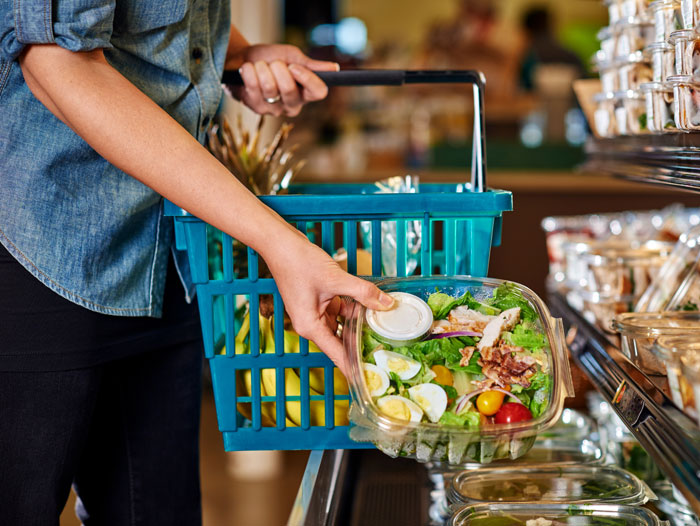Trends and Countertrends Captivate Today’s Shoppers
September 29, 2023 | 4 min to read
New research from Culinary Visions reveals that modern consumers prioritize both quick meals and social food experiences. Amid hectic lifestyles, immersive events like food festivals are popular, with 71% valuing social occasions in shopping. Consumers seek detailed food information, with 80% wanting insights on fresh items, and 72% appreciate knowledgeable staff. A mega-trend emphasizes local and sustainable foods, with 77% willing to pay more for local products, while 83% enjoy exploring international cuisines.

Understanding trends can feel like trying to hit a moving target. New research by Culinary Visions sheds light on trends and countertrends identified in a nationwide study of over 2,100 consumers. The study found the hectic pace of modern life requires fast fuel as much as personal service and social food-centric experiences.
Gaining an understanding of these trends at play in the marketplace can help retailers satisfy and delight today’s shoppers, who seem to want it all when it comes to food.
What emerged from this inquiry was awareness of the force of cultural contradictions in driving the trends. For many major trends identified, equally powerful countertrends emerged. The research identified three important insights for retailers:
1. FAST FUELING AND TAKING TIME TO SOCIALIZE
Pandemic-weary consumers have returned with enthusiasm to immersive experiences, such as food festivals, street markets and fancy food emporiums where food is both the attraction and the entertainment. Seventy-one percent of those surveyed in the recent study said they enjoy a food market experience because it is just as much a social occasion as it is a shopping trip.
The volume of commitments in everyday life is also making fast fueling an important part of today’s lifestyle. Fifty-seven percent of survey participants said sharing a meal with a friend or family members in the car suits their hectic lifestyle.
Although consumers continue to embrace technology that enables shopping with ease, in-store experiences can create the excitement and appeal of a food market and draw customers back in-store.
2. GETTING FACTS ON DEMAND AND LEARNING FROM EXPERTS
Food savvy consumers want to know as much as they can about the food they consume, and that goes beyond required ingredient statements on packaged goods. Technology that makes information easily accessible at the point of sale can encourage purchases in fresh departments as well. Eighty percent of shoppers agreed they would like to have more information about the sources of the fresh items they purchase in the grocery store readily available to them in-store.
When it comes to food, a flavor experience can make all the difference. Eighty-six percent of those surveyed said they enjoyed sampling products when shopping for groceries. Sampling in the deli department can go beyond offering a taste that assures flavor and freshness by serving up a quick meal idea. It also offers a cross-merchandising opportunity for the store. For example, roasted seasonal vegetables with protein, whole grain or wrap featured at the sampling area can build store sales.
There is growing appreciation of employees who have expert knowledge of the items in the department. Seventy-two percent of survey participants said that experts available to answer questions on specific food items made them feel like it was worth the trip to the store.
3. APPRECIATING LOCAL AND EXPLORING THE WORLD
The desire and willingness to pay for local and sustainable foods has become a mega-trend and a boon for the deli department. Survey participants expressed an appreciation for everyone involved in bringing their food to the table.
Furthermore, 77% said they are willing to pay more for food that comes from local producers. Having the opportunity to meet the producer adds to the appeal. Seventy-five percent of consumers surveyed said they like talking to food vendors who are passionate about the products they sell.
While local foods have a powerful appeal, international foods and flavors are also enticing. Even though global travel has been dampened in recent years, many countries are promoting their culture around the world with culinary diplomacy programs that introduce new foods to consumers.
Eighty-three percent of consumers in this survey said they enjoy exploring new cultures through food. Modern consumers have a powerful sense of culinary adventure when it comes to exploring global foods.
TRANSLATING THE TREND RESEARCH
Trends are multidimensional, and food trends must be viewed from a broad perspective. For this study, the Culinary Visions research team collected insight from a wide range of experts working in varied creative disciplines that are important to modern consumer lifestyles. In addition to food and culinary professionals, kitchen designers, architects, fashion designers and fine artists are among those who contributed ideas that drove the direction of this consumer study.
There is no one-size-fits-all formula when it comes to creating a destination department. The interests and desires of local communities assure relevance when consumers have a wide range of alternatives.
In today’s food culture, trends and countertrends both have the power to influence the decision-making process. Success may require pushing boundaries just enough to captivate customers with something new.
Sharon Olson is executive director of Culinary Visions, a division of Olson Communications Inc. based in Chicago, IL. Culinary Visions is a food-focused insight and trend-forecasting firm that provides original consumer and culinary professional research for companies in the food industry.
2 of 8 article in DeliBusiness Fall 2023

